-

新人教版高中英语必修2Unit 3 The Internet-Reading For Writing教案一
⑦identity theft 身份盗窃⑧chat room 聊天室⑨draft your blog post 起草博客帖子⑩post embarrassing photos 张贴尴尬照片 【话题句式】 1. How do you stay safe online and avoid bad experiences on the Internet? 你如何在网上保持安全, 避免在网上的不良经历? 2. I’m not an expert, but many years as a blogger have taught me a thing or two. 我不是专家, 但作为一个博主, 我已经学了好几年了。 3. If you see or read something that makes you feel uncomfortable, leave the site immediately. 如果你看到或读到一些让你觉得不舒服的东西, 立即离开这个网站。4. Don’t give out your address or phone number. 别告诉别人你的地址或电话号码。 5. Identity theft is a common and serious problem. 身份盗窃是一个常见而严重的问题。6. Being online is no excuse for being rude, and you don’t want to become a target for a troll or cyberbully. 上网并不是无礼的借口, 你也不想成为发挑衅帖子的人或网络恶霸的目标。 7. Trolls often use several false names so that they can stay on a site. 发挑衅帖子的人经常使用几个假名, 这样他们就可以留在一个网站上。8. However, the more polite you are, the less likely it is you will be attacked. 然而, 你越有礼貌, 你被攻击的可能性就越小。

新人教版高中英语必修2Unit 5 Music-Discovering Useful Structures教案一
Step1:自主探究。1.(教材P52)Born(bear) in the USA on 2 January 1970, Whitacre began studying music at the University of Nevada in 1988.2.(教材P52) Moved(move) by this music, he said, “It was like seeing color for the first time.”3.(教材P56)I was very afraid and I felt so alone and discouraged(discourage).4.(教材P58)Encouraged(encourage) by this first performance and the positive reaction of the audience, I have continued to play the piano and enjoy it more every day.Step2:语法要点精析。用法1:过去分词作表语1).过去分词可放在连系动词be, get, feel, remain, seem, look, become等之后作表语,表示主语所处的状态Tom was astonished to see a snake moving across the floor.汤姆很惊讶地看到一条蛇正爬过地板。Finally the baby felt tired of playing with those toys.终于婴儿厌倦了玩那些玩具。注意:1).过去分词作表语时与被动语态的区别过去分词作表语时,强调主语所处的状态;而动词的被动语态表示主语是动作的承受者,强调动作。The library is now closed.(状态)图书馆现在关闭了。The cup was broken by my little sister yesterday.(动作)昨天我妹妹把杯子打碎了。2)感觉类及物动词的现在分词与过去分词作表语的区别过去分词作表语多表示人自身的感受或事物自身的状态,常译作“感到……的”;现在分词多表示事物具有的特性,常译作“令人……的”。
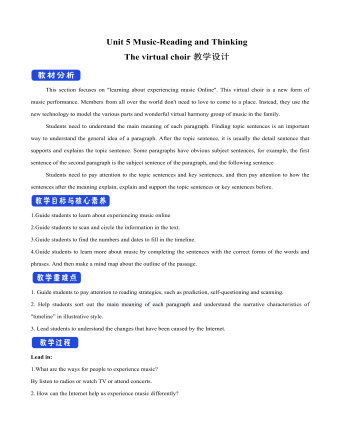
新人教版高中英语必修2Unit 5 Music-Reading and Thinking教案一
This section focuses on "learning about experiencing music Online". This virtual choir is a new form of music performance. Members from all over the world don't need to love to come to a place. Instead, they use the new technology to model the various parts and wonderful virtual harmony group of music in the family. Students need to understand the main meaning of each paragraph. Finding topic sentences is an important way to understand the general idea of a paragraph. After the topic sentence, it is usually the detail sentence that supports and explains the topic sentence. Some paragraphs have obvious subject sentences, for example, the first sentence of the second paragraph is the subject sentence of the paragraph, and the following sentenceStudents need to pay attention to the topic sentences and key sentences, and then pay attention to how the sentences after the meaning explain, explain and support the topic sentences or key sentences before.1.Guide students to learn about experiencing music online2.Guide students to scan and circle the information in the text.3.Guide students to find the numbers and dates to fill in the timeline.4.Guide students to learn more about music by completing the sentences with the correct forms of the words and phrases. And then make a mind map about the outline of the passage.1. Guide students to pay attention to reading strategies, such as prediction, self-questioning and scanning.2. Help students sort out the main meaning of each paragraph and understand the narrative characteristics of "timeline” in illustrative style.3. Lead students to understand the changes that have been caused by the Internet.
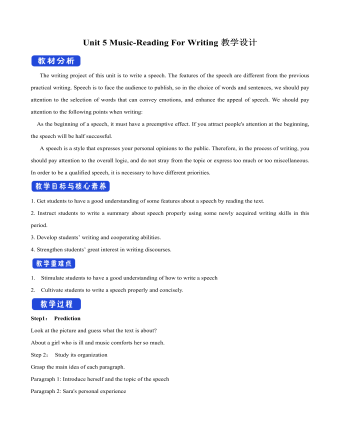
新人教版高中英语必修2Unit 5 Music-Reading For Writing教案一
(4)Now we have heard a number of outstanding speeches ... 我们已经聆听了许多精彩的发言……(5)Because we wanted the nations of the world, working together, to deal with ... 因为我们希望全世界各国团结起来去应对……(6)And if we do not act ... 如果我们不采取行动……(7)Now, I share the concerns that have been expressed ... 我也同意对于……表达的担心(8)Let us show the world that by working together we can ... 让我们告诉全世界,通过一起努力我们可以……(9)It is now time for us to ... 是时候我们……(10)And I have always wished that ... 我一直希望……(11)Thank you for letting me share this day with me.感谢你们和我共度这一天。实践演练:假如你是高中生李华,你校将举办一次以“音乐”为主题的演讲比赛,请你按照主题,写下你的演讲稿。注意:词数100左右。First of all, thank you for listening to my speech. My topic is: love music like love yourself.Music is like the air we need to maintain our normal lives around us. You can't imagine how terrible a world without music would be. Movies and TV shows have no music, only dry conversations and scenes; mobile phones only vibrations; streets only noisy crowds; cafes, western restaurants only depressed meals. What a terrible world it is!As a student, I hope we all can enjoy the fun brought by music in our spare time. Instead of just listening to music, we can even make our own music. Let's enjoy the fun of music!Thanks again for your attention!
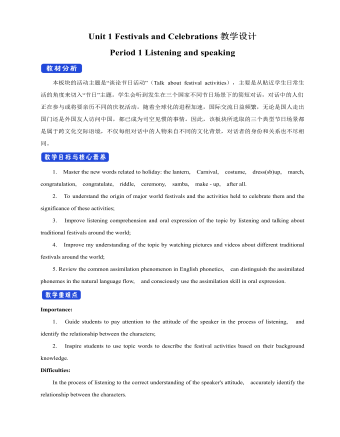
新人教版高中英语必修3Unit 1 Festivals and Celebrations教学设计一
本板块的活动主题是“谈论节日活动”(Talk about festival activities),主要是从贴近学生日常生活的角度来切入“节日”主题。学生会听到发生在三个国家不同节日场景下的简短对话,对话中的人们正在参与或将要亲历不同的庆祝活动。随着全球化的进程加速,国际交流日益频繁,无论是国人走出国门还是外国友人访问中国,都已成为司空见惯的事情。因此,该板块所选取的三个典型节日场景都是属于跨文化交际语境,不仅每组对话中的人物来自不同的文化背景,对话者的身份和关系也不尽相同。1. Master the new words related to holiday: the lantern, Carnival, costume, dress(sb)up, march, congratulation, congratulate, riddle, ceremony, samba, make - up, after all. 2. To understand the origin of major world festivals and the activities held to celebrate them and the significance of these activities;3. Improve listening comprehension and oral expression of the topic by listening and talking about traditional festivals around the world;4. Improve my understanding of the topic by watching pictures and videos about different traditional festivals around the world;5. Review the common assimilation phenomenon in English phonetics, can distinguish the assimilated phonemes in the natural language flow, and consciously use the assimilation skill in oral expression. Importance:1. Guide students to pay attention to the attitude of the speaker in the process of listening, and identify the relationship between the characters;2. Inspire students to use topic words to describe the festival activities based on their background knowledge. Difficulties:In the process of listening to the correct understanding of the speaker's attitude, accurately identify the relationship between the characters.
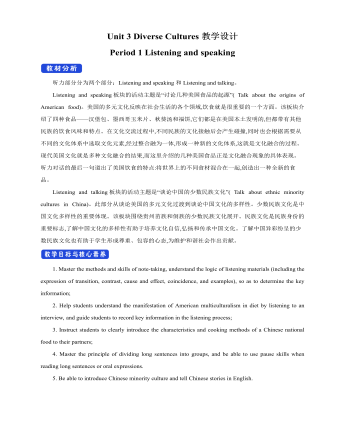
新人教版高中英语必修3Unit 3 Diverse Cultures教学设计一
Activity 81.Grasp the main idea of the listening.Listen to the tape and answer the following questions:Who are the two speakers in the listening? What is their relationship?What is the main idea of the first part of the listening? How about the second part?2.Complete the passage.Ask the students to quickly review the summaries of the two listening materials in activity 2. Then play the recording for the second time.Ask them to complete the passage and fill in the blanks.3.Play the recording again and ask the students to use the structure diagram to comb the information structure in the listening.(While listening, take notes. Capture key information quickly and accurately.)Step 8 Talking Activity 91.Focus on the listening text.Listen to the students and listen to the tape. Let them understand the attitudes of Wu Yue and Justin in the conversation.How does Wu Yue feel about Chinese minority cultures?What does Justin think of the Miao and Dong cultures?How do you know that?2.learn functional items that express concerns.Ask students to focus on the expressions listed in activity. 3.And try to analyze the meaning they convey, including praise (Super!).Agree (Exactly!)"(You're kidding.!)Tell me more about it. Tell me more about it.For example, "Yeah Sure." "Definitely!" "Certainly!" "No kidding!" "No wonder!" and so on.4.Ask the students to have conversations in small groups, acting as Jsim and his friends.Justin shares his travels in Guizhou with friends and his thoughts;Justin's friends should give appropriate feedback, express their interest in relevant information, and ask for information when necessary.In order to enrich the dialogue, teachers can expand and supplement the introduction of Miao, dong, Lusheng and Dong Dage.After the group practice, the teacher can choose several groups of students to show, and let the rest of the students listen carefully, after listening to the best performance of the group, and give at least two reasons.
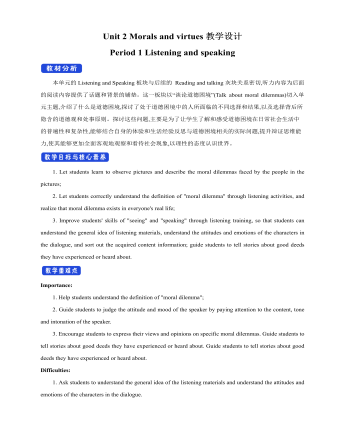
新人教版高中英语必修3Unit 2 Morals and virtues教学设计一
(2) students are divided into groups according to the requirements of activity 3. Each student shares a story of personal experience or hearing-witnessing kindness, and then selects the most touching story in the group and shares it with the whole class. Before the students share the story, the teacher can instruct them to use the words and sentence patterns in the box to express. For example, the words in the box can be classified:Time order: first of all, then, after that, later, finally logical relationship :so, however, although, butTeachers can also appropriately add some transitional language to enrich students' expression:Afterwards, afterwards, at last, in the end, eventuallySpatial order: next to, far from, on the left, in front ofOtherwise, nevertheless, as a result, therefore, furthermore, in addition, as well asSummary: in a word, in short, on the whole, to sum up, in briefStep 8 Homework1. Understand the definition of "moral dilemma" and establish a correct moral view;2. Accumulate vocabulary about attitudes and emotions in listening texts and use them to express your own views;3. Complete relevant exercises in the guide plan.1、通过本节内容学习,学生能否理解理解“道德困境”的定义;2、通过本节内容学习,学生能否通过说话人所表达的内容、说话的语气、语调等来判断其态度和情绪;3、通过本节内容学习,学生能否针对具体的道德困境发表自己的看法和见解,能否掌握听力理训练中的听力策略。
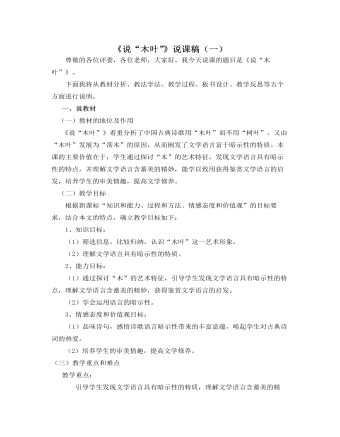
《说“木叶”》说课稿(一) 2021-2022学年统编版高中语文必修下册
这五个问题,主要从学情出发,由浅入深,从感知到理论,培养学生的鉴赏能力。第三环节:延伸探究、展示成果(多媒体显示)走出文本,引入课外同类文学现象,让学生能够触类旁通,举一反三,把教材作为一个例子,让学生在深入的文学鉴赏中再次获得语言的审美。同学们初步掌握了文学语言具有暗示性的性质后,还需巩固、提升鉴赏能力!这里我采取的方法是:引导学生认真阅读文本,经小组合作探究后,得出本组的鉴赏成果并加以展示,这里重在培养学生的理解能力和分析综合能力。问题是:1、 请结合下面三首词的意境,选用残红、落红、乱红填空。2、 阅读下面这些句子,理解“燕”在词语中的暗示意义。该环节充分体现了 “ 教师为主导,学生为主体”的原则。老师的适时点拨,让学生的鉴赏思路更加清晰。学生通过合作探究,理解能力和分析综合能力得到了提升。
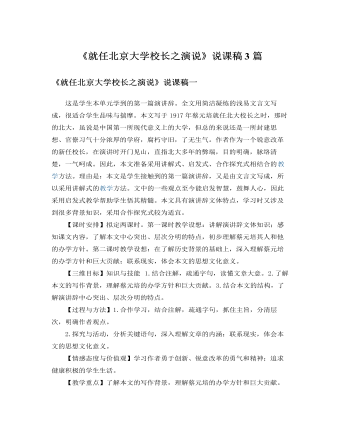
人教版高中语文必修2《就任北京大学校长之演说》说课稿3篇
(三)教学重、难点1、教学重点:结合课文,了解演讲辞针对性强、条理清楚、通俗易懂、适当的感情色彩等特点。2、教学难点:深入理解文章内涵,联系现实,体会本文的现实意义二、说学情高中学生在初中阶段已经接触过演讲辞了,对演讲词的特点已经有了一些基本的知识,因此本轮的教学应该让他们在此基础上有所提高。本文是学生在高中阶段第一次接触演讲辞,有必要让他们了解演讲辞的特点及课文如何体现这些特点的。随着年龄的增长,生活阅历的增加,高中学生正逐渐形成自己对世界、对人生的看法,蔡元培先生的这篇文章能很好地激发他们对当前的高中学习和未来的大学生活进行思考。此外,学生对北大的历史及蔡元培先生作这番演讲的时代背景了解不深,应作出补充说明。
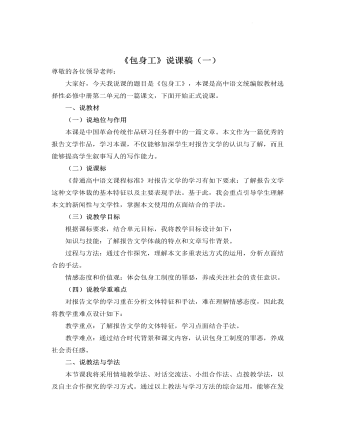
《包身工》说课稿(一) 2021-2022学年统编版高中语文选择性必修中册
首先请同学设想:“如果你是作者,当你准备写一篇以包身工为题材的文章时,会从哪些方面选材?”而“本文又是如何将这些材料组织起来的?”这一环节能够使学生参与到教学过程中来,通过问题能够引导学生关注本文的选材类型和表达方式,区分文中穿插的感性、理性材料,从而理解报告文学兼文学性、议论性于一体的文学特质。然后请同学阅读表现包身工起床情形的场面描写(1-6段),并引导学生分析该段表达效果;再请同学们阅读“芦柴棒”被虐待段(16-20段),并引导同学们比较两个片段在选材上有何区别,进而归纳点面结合的手法的艺术效果。最后请学生找出文中其他运用点面结合手法的段落,并尝试自主分析。这一环节能够引导学生直观地感受本文场面描写的作用,并分析点面结合手法的艺术效果,同时也让学生通过练习探究掌握分析该手法的方法。
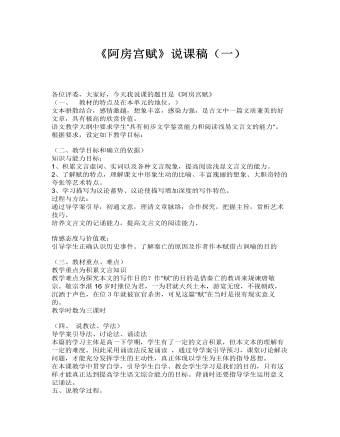
《阿房宫赋》说课稿(一) 2021-2022学年统编版高中语文必修下册
各位评委,大家好,今天我说课的题目是《阿房宫赋》 (一、 教材的特点及在本单元的地位。)文本骈散结合,感情激越,想象丰富,感染力强,是古文中一篇文质兼美的好文章,具有极高的欣赏价值。语文教学大纲中要求学生“具有初步文学鉴赏能力和阅读浅易文言文的能力“。根据要求,设定如下教学目标:(二、教学目标和确立的依据) 知识与能力目标:1、积累文言虚词、实词以及各种文言现象,提高阅读浅显文言文的能力。2、了解赋的特点,理解课文中形象生动的比喻、丰富瑰丽的想象、大胆奇特的夸张等艺术特点。3、学习描写为议论蓄势、议论使描写增加深度的写作特色。过程与方法:通过导学案引导,初通文意,理清文章脉络;合作探究,把握主旨,赏析艺术技巧。培养文言文的记诵能力,提高文言文的阅读能力。情感态度与价值观:引导学生正确认识历史事件。了解秦亡的原因及作者作本赋借古讽喻的目的
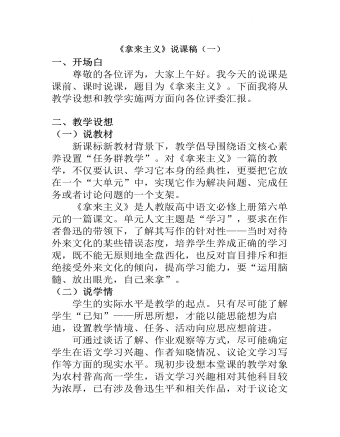
《拿来主义》说课稿(一) 2022-2023学年统编版高中语文必修上册
(三)说目标鉴于以上学情分析,结合单元学习任务群——思辨性阅读与表达的定位,确定本课教学目标为通过设置任务情境,带领学生在活动中认识表达的有针对性、论述的层次逻辑性以及感受文章蕴含的批判力量。其中以表达的有针对性为教学重点,以论述的层次逻辑性为难点。(四)说理念根据课标和教材特点,结合学情,授课将依托“学为中学理论”“建构主义学习理论”和“最近发展区理论”等,积极开展阅读与鉴赏、表达与交流、梳理与探究等语文实践活动提升学生语文核心素养。三、教学实施(一)设定学习情境为引导广大学生合理对待外来文化,学校辩论社拟设定辩题——如何正确对待外来文化展开辩论。有同学说坚决抵制外来文化(正方),也有同学说要积极吸收(反方)……那么如果你是其中一位辩手,你将在《拿来主义》中如何撷取素材呢?
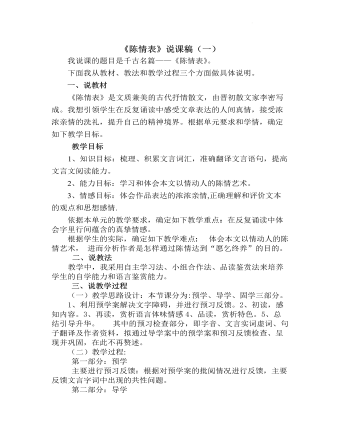
《陈情表》说课稿(一) 2021-2022学年统编版高中语文选择性必修下册
4、学习任务三:品读,赏析特色,深入探究。(解决“为什么这么陈情“的问题)文学史上,以获得“高难度”的险助而又收“高效率”奇功的,首推李密的《陈情表》。“抗君命”、“逆圣旨”,李密是为“辞不赴命”而上书的。让学生再读课文,结合导学案中的背景介绍,思考作者为什么这样陈情。 【方法导引】再读文本,深入思考作者除了从亲情入手打动晋武帝,还从哪些方面陈情以达到自己想要的效果?要求:独立思考,小组合作,梳理归纳,到黑板上展示。教师补充归纳:本文出于情,归于理,先动之以情,再晓之以理。李密是亡国旧臣,惹恼晋武帝,会被株连九族。先以祖孙相依为命的亲情凄切婉转的表明心意,唤起晋武帝的怜悯之心,再以“报国恩”“徇私情”的两难和朝廷以“孝”治国以及自己为官追求等,打消皇帝疑虑,最终提出先尽孝后尽忠的解决方案,以情动人,构思缜密。整篇《陈情表》密布着感情的浓云,陈情于事,寓理于情,凄恻动人。
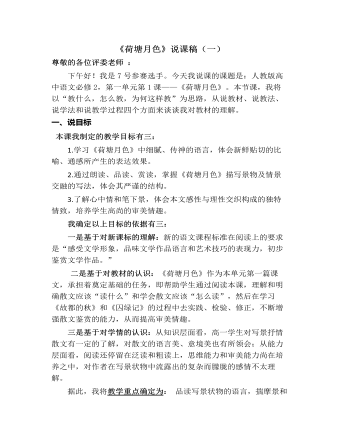
《荷塘月色 》说课稿(一) 2021-2022学年统编版高中语文必修上册
一、说目标本课我制定的教学目标有三:1.学习《荷塘月色》中细腻、传神的语言,体会新鲜贴切的比喻、通感所产生的表达效果。2.通过朗读、品读、赏读,掌握《荷塘月色》描写景物及情景交融的写法,体会其严谨的结构。3.了解心中情和笔下景,体会本文感性与理性交织构成的独特情致,培养学生高尚的审美情趣。我确定以上目标的依据有三:一是基于对新课标的理解:新的语文课程标准在阅读上的要求是“感受文学形象,品味文学作品语言和艺术技巧的表现力,初步鉴赏文学作品。”二是基于对教材的认识:《荷塘月色》作为本单元第一篇课文,承担着奠定基础的任务,即帮助学生通过阅读本课,理解和明确散文应该“读什么”和学会散文应该“怎么读”,然后在学习《故都的秋》和《囚绿记》的过程中去实践、检验、修正,不断增强散文鉴赏的能力,从而提高审美情趣。
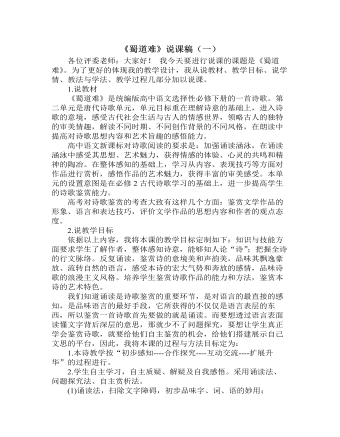
《蜀道难》说课稿(一) 2021-2022学年统编版高中语文选择性必修下册
(3)夸张到极致的技巧: (学生寻找出诗歌中的夸张语句,谈出感受)(4)多样的诗歌意境: 为了表达主观感受与目的的需要,诗歌中构织不同的意境:高峻、宏伟、神奇、凄清、恐怖等各种意境均有描绘,而这些意境又统统表现一个“难”字。(5)神秘的传说: “五丁开山”“太阳神回车”“子规哀啼”等传说的出现,使全诗笼罩一种神秘气氛,也从另一个角度表现出了一个“难”字。九.课后探讨本文主旨历来争议不定,明确诗歌的主旨和情感。 我首先指导方法, “知人论世” 是评论文学作品的一种原则 。知人,就是了解作者其人及作者与作品的关系。论世,就是要了解作者所处的时代、环境。接着打出李白在长安的介绍。说明李白踌躇满志而来,却受到权贵的忌恨,被放还乡。接着打出唐玄宗时期的介绍,说明太平景象背后潜伏的危机。然后让学生分组讨论,本课的写作意图是什么?
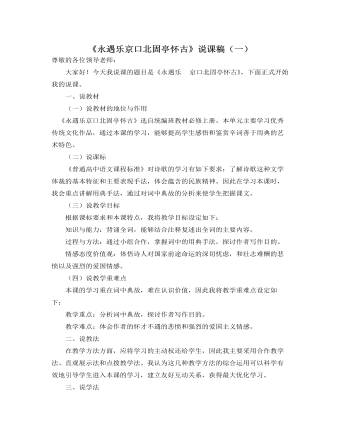
《永遇乐 · 京口北固亭怀古》说课稿(一) 2021-2022学年统编版高中语文必修上册
(三)以读带讲,感知文本1.学生朗读首先我会让学生结合书下的注释自由大声的朗读本篇课文,扫清文字障碍,感知词意。此环节可以让学生在诵读中解决词中的生字困难,疏通文意。2.教师范读我会声情并茂、感情充沛的进行配乐朗诵。此环节力求让学生感受到词的音乐美,懂得词的朗诵方法,为深入理解词的内容做准备。(四)精讲细读,深入文本此环节主要解决本课的重点,所以我会运用合作教学法和点拨教学法引导学生分析词中典故,探讨作者写作目的。首先我将学生分为孙权刘裕组、刘义隆组、拓跋焘组、廉颇组四个小组。然后对这四个小组分别提出思考问题,让学生以小组为单位解决我提出的问题。在学生讨论结束后分别找每个小组中的一位同学回答,并引导点拨学生答案。孙权刘裕组:
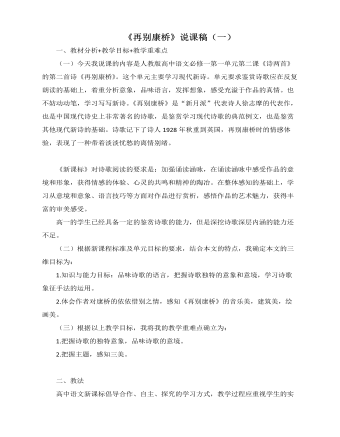
《再别康桥》说课稿(一) 2020-2021学年统编版高中语文选择性必修下册
2.对比联想法。让学生在诵读的基础上,对《再别康桥》中康桥美景的赏析和意象进行解读,引导学生欣赏诗歌的画面美,从而受到审美的体验。3.探究式学习法。引导学生对《再别康桥》情感和主题的探究。充分发挥学生自主学习的能力,引导学生主动地获取知识,重视学生的实践活动。三、学法1、诵读法 加强诵读,这是阅读诗词的一般方法。2、体悟法 通过意象把握情感,主要是让学生设身处地走进雨巷去感悟。3、联想比较法 通过与诗人的其他作品的比较学习,体会创作风格及作者情感。四、教学过程教学过程设计一、导入自古以来,离别总免不了沉重的愁绪。比如王维《宋元二使安西》:劝君更尽一杯酒,西出阳关无故人。李白《黄鹤楼送孟浩然之广陵》:孤帆远影碧空尽,唯见长江天际流。柳永《雨霖铃》执手相看泪眼,竟无语凝噎。正所谓自古多情伤离别,更那堪冷落清秋节啊。(设计目的:以离别主题的诗歌导入课文,让学生更快地进入课文情境。)
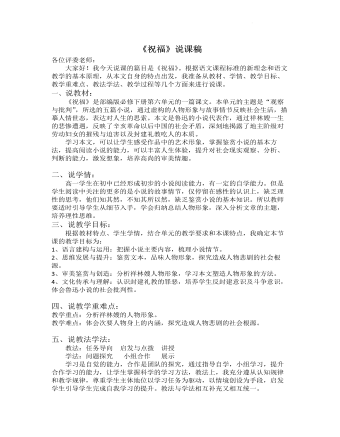
《祝福》说课稿(一) 2021-2022学年统编版高中语文必修下册
三、说教学目标:根据教材特点、学生学情,结合单元的教学要求和本课特点,我确定本节课的教学目标为:1、语言建构与运用:把握小说主要内容,梳理小说情节。2、思维发展与提升:鉴赏文本,品味人物形象,探究造成人物悲剧的社会根源。3、审美鉴赏与创造:分析祥林嫂人物形象,学习本文塑造人物形象的方法。4、文化传承与理解:认识封建礼教的罪恶,培养学生反封建意识及斗争意识,体会鲁迅小说的社会批判性。四、说教学重难点:教学重点:分析祥林嫂的人物形象。教学难点:体会次要人物身上的内涵,探究造成人物悲剧的社会根源。五、说教法学法:教法:任务导向 启发与点拨 讲授学法:问题探究 小组合作 展示学习是自觉的能力,合作是团队的探究,通过指导自学,小组学习,提升合作学习的能力,让学生掌握科学的学习方法,教法上,我充分遵从认知规律和教学规律,尊重学生主体地位以学习任务为驱动,以情境创设为手段,启

《念奴娇 赤壁怀古》说课稿(一) 统编版高中语文必修上册
一、说教材:(一)教材的地位和作用《念奴娇﹒赤壁怀古》是部编版高中语文教材必修上册第9课的课文。它与辛弃疾的《永遇乐﹒京口北固亭怀古》,李清照的《声声慢》共同入选该册教材第三单元阅读古诗词,感悟人生这一学习专题。本词是苏轼的代表作,也是豪放词的名篇,在古诗词教学中占有重要的地位。优美的诗词是中华传统文化的瑰宝,学习这些诗词的目的在于培养学生鉴赏古代诗词作品的能力,在分析、鉴赏中感悟前人丰饶的情思,博大的智慧,从而提高学生的人文素养,提高文化品味。这首词写于元丰五年,是苏轼被贬黄州游赤鼻矶所作。本词感情激荡,意境雄浑壮阔。全词融写景、咏史、抒情为一体。通过学习,学生可以获得一些鉴赏诗词的基本要领,领略壮阔意境,感受豪放词风;同时学习苏轼在逆境中依然乐观旷达的人生观。
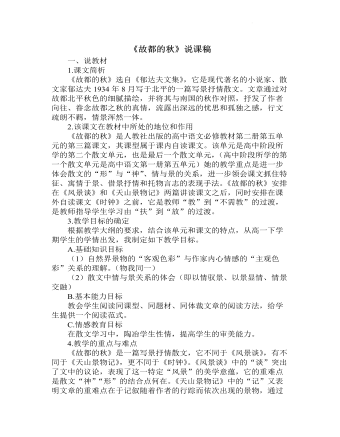
《故都的秋》说课稿(一) 2021-2022学年统编版高中语文必修上册
1.圈点、勾画重要词语评点的读书习惯和方法。如全出描绘秋色的词语,标出传递秋声的词语,点评北国故都秋色的词语、南国秋色的词语,摄取主要信息。2.口、耳、手、脑并用的读书习惯和方法。如默读、听读、跟读时,不动笔墨不看书,不动思维不读书。3.学以致用的迁移运用方法。如投影仪的练习设计,让学生由品文到品读诗词等。四、说教学程序(一)导语激趣人们常说,良好的开端是成功的一半,因而导语也就显得十分重要。好的导语能营造适宜的课堂氛围,集中学生的注意力,调动学生的学习情绪,使学生对学习的内容产生浓厚的兴趣。这篇课文的导语我是这样来设计的:同学们,自古诗家多爱秋,因为秋是文人心中的一粒愁种子。“无边落木萧萧下,不尽长江滚滚来。”这是杜甫面对秋风登高而抒怀;“梧桐更兼细雨,到黄昏,点点滴滴。这次第,怎一个愁字了得。”这是李清照面对秋雨而吟咏愁情。秋风秋雨愁煞人啦。

